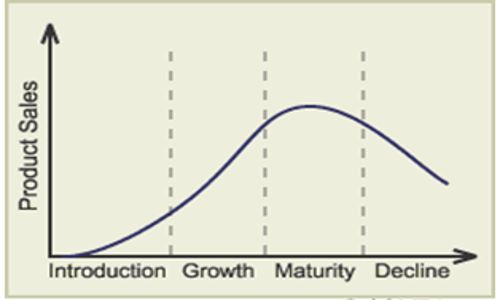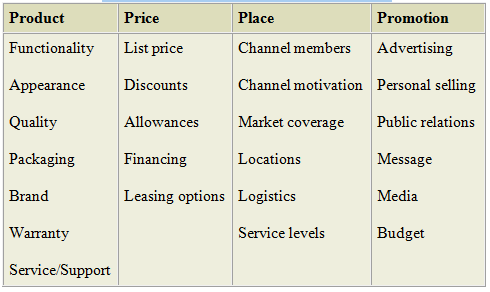Product Life Cycle
A new product progresses through a sequence of stages from introduction to growth, maturity, and decline. This sequence is known as the product life cycle and is associated with changes in the marketing situation, thus impacting the marketing strategy and the marketing mix.
The product revenue and profits can be plotted as a function of the life-cycle stages as shown in the graph below:
Product Life Cycle Diagram

Introduction Stage
In the introduction stage, the firm seeks to build product awareness and develop a market for the product. The impact on the marketing mix is as follows:
- Product branding and quality level is established, and intellectual property protection such as patents and trademarks are obtained.
- Pricing may be low penetration pricing to build market share rapidly, or high skim pricing to recover development costs.
- Distribution is selective until consumers show acceptance of the product.
- Promotion is aimed at innovators and early adopters. Marketing communications seeks to build product awareness and to educate potential consumers about the product.
Growth Stage
In the growth stage, the firm seeks to build brand preference and increase market share.
- Product quality is maintained and additional features and support services may be added.
- Pricing is maintained as the firm enjoys increasing demand with little competition.
- Distribution channels are added as demand increases and customers accept the product.
- Promotion is aimed at a broader audience.
Maturity Stage
At maturity, the strong growth in sales diminishes. Competition may appear with similar products. The primary objective at this point is to defend market share while maximizing profit.
- Product features may be enhanced to differentiate the product from that of competitors.
- Pricing may be lower because of the new competition.
- Distribution becomes more intensive and incentives may be offered to encourage preference over competing products.
- Promotion emphasizes product differentiation.
Decline Stage
As sales decline, the firm has several options:
- Maintain the product, possibly rejuvenating it by adding new features and finding new uses.
- Harvest the product – reduce costs and continue to offer it, possibly to a loyal niche segment.
- Discontinue the product, liquidating remaining inventory or selling it to another firm that is willing to continue the product.
The marketing mix decisions in the decline phase will depend on the selected strategy. For example, the product may be changed if it is being rejuvenated, or left unchanged if it is being harvested or liquidated. The price may be maintained if the product is harvested, or reduced drastically if liquidated.
The Marketing Mix
(The 4 P’s of Marketing)
The major marketing management decisions can be classified in one of the following four categories:
- Product
- Price
- Place (distribution)
- Promotion
These variables are known as the marketing mix or the 4 P’s of marketing. They are the variables that marketing managers can control in order to best satisfy customers in the target market. The marketing mix is portrayed in the following diagram:
The Marketing Mix

The firm attempts to generate a positive response in the target market by blending these four marketing mix variables in an optimal manner.
Product
The product is the physical product or service offered to the consumer. In the case of physical products, it also refers to any services or conveniences that are part of the offering.
Product decisions include aspects such as function, appearance, packaging, service, warranty, etc.
Price
Pricing decisions should take into account profit margins and the probable pricing response of competitors. Pricing includes not only the list price, but also discounts, financing, and other options such as leasing.
Place
Place (or placement) decisions are those associated with channels of distribution that serve as the means for getting the product to the target customers. The distribution system performs transactional, logistical, and facilitating functions.
Distribution decisions include market coverage, channel member selection, logistics, and levels of service.
Promotion
Promotion decisions are those related to communicating and selling to potential consumers. Since these costs can be large in proportion to the product price, a break-even analysis should be performed when making promotion decisions. It is useful to know the value of a customer in order to determine whether additional customers are worth the cost of acquiring them.
Promotion decisions involve advertising, public relations, media types, etc.
A Summary Table of the Marketing Mix
The following table summarizes the marketing mix decisions, including a list of some of the aspects of each of the 4Ps.
Summary of Marketing Mix Decisions

Information Source:
















